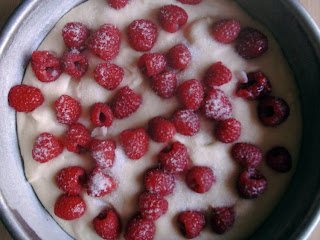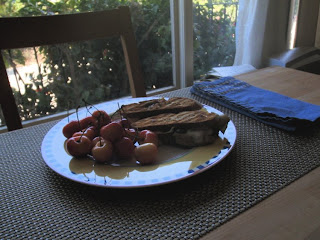Everyone in the family likes ice cream. B likes it, I like it, Jackson and Jasper like it. (The cats don't get their own servings, but they do enjoy licking the bowls when we're done. Jackson, however, only likes licking bowls that don't have spoons in them; for some reason he is irrationally scared of utensils.) Jackson spends a lot of time in the kitchen with me; in addition to tasting the ice cream, he likes watching the machine while it's churning.

He is endlessly fascinated, and will perch there for the entire thirty or so minutes that the machine is whirring away—which is frequently, because right now in the freezer we have:
- espresso ice cream
- Earl Grey tea ice cream (JL and A got to choose if they wanted coffee or tea after dinner last week, but they semi-cheated and chose both)
- peach frozen yogurt
- blueberry ice cream
- honey-pistachio ice cream
- strawberry ice cream
- Meyer lemon ice cream
Wow. That list makes me sound like a crazy person. Or more specifically, a crazy person with the one specific problem of making too much ice cream. Perhaps they'll add this disorder to the forthcoming DSM-V (thoughts, JB?).
But there are still so many flavors to try! I actually can't believe what I'm about to write, but we've had the ice cream machine for over three years and, when you count it up, four of the seven bulleted flavors above are first-run batches. (Even more remarkably, only one of them, the honey-pistachio, was a disappointment; soon I'll be sacrificing the remnants, because it's time to liberate some Tupperware.)
It's not just making ice cream that's a problem, though; there's also the eating. The amount of ice cream we have in the freezer reminds me of an interaction I had with an attending physician in clinic a few months ago. Before I went into a patient's room, he said, "Make sure you ask Mr. A how he's doing on his new diet. Last time I saw him I found out that he was eating ice cream for dessert three or four times a week—isn't that ridiculous?"
"TOTALLY ridiculous!" I agreed, lying through my teeth.
(My weight's stable, I swear. So is B's.)
This post wasn't supposed to be about ice cream, believe it or not. I meant to write about something that goes very well with ice cream but is not itself ice cream. As you might expect, we often serve ice cream for dessert when we have guests over. I like baking, but some of the unusual ice cream flavors would compete negatively with a pie or a tart or a cake. I've been looking for something that would complement ice cream without distracting from it, and this afternoon I did: the stalwart almond macaroon. I had forgotten how much I love macaroons. Chewy, sweet, airy, bite-size, perfect.
The idea of pairing them with ice cream wasn't really mine. I happened to be reading the summer fruit section of Lindsey Shere's Chez Panisse Desserts (lots of ice creams in there, so clearly it's not just me that's obsessed), and she recommended serving one of the frozen desserts with macaroons on the side. It had been years since I had made a macaroon. I remember using a Julia Child recipe once (by the way, so excited to see Meryl Streep), but for some reason macaroons had fallen off my cookie-making radar. It seems like everyone adores coconut macaroons, but I prefer to stick with the nut variety since saying that I don't love coconut is putting it mildly.
Today seemed like the perfect day to experiment with macaroons, because I was trying to procrastinate from doing research; after all, you can only spend so many hours a day staring at tables in Excel. First, Wikipedia taught me that the word macaroon comes from the same root as macaroni (weird, right?). Then, I got down to business. I ground nuts, I whipped egg whites (finally, a use for some of the whites generated in the ice cream custard-making process), I folded, I piped rounds onto the Silpat, I baked for seven minutes, I watched the macaroons deflate and wrinkle quickly once out of the oven, I peeled them off the Silpat, and then I ate my afternoon snack.
The macaroons were delicious with a glass of iced tea. I will eat the macaroons with ice cream later, and I'm sure they'll go perfectly. Truth be told, I may have already tested this theory with a spoonful of blueberry ice cream spread lavishly on top of a macaroon; it may have been so delicious that I had to wash the spoon quickly so that I couldn't fix another one and thereby spoil my dinner. Next time, I'm going to enter uncharted waters: hazelnut macaroons, and possibly some sort of ice cream sandwich. For now, enjoy these macaroons, with or without ice cream!
Almond Macaroons
Adapted from Lindsey Shere's Chez Panisse Desserts
Makes: 36 cookies or so
Time: 10 minutes active, 30 minutes total
1/2 c. sliced almonds
1 c. powdered sugar
2 egg whites
1/4 t. cream of tartar
Preheat oven to 400. Line two cookie sheets with Silpats or parchment paper (both work equally well). Grind the almonds in a food processor (I used my mini-Cuisinart), or finely chop. In a medium-sized bowl, mix the almonds and powdered sugar together. In a separate small bowl, beat the egg whites with cream of tartar until stiff peaks form, about five minutes. Fold the egg whites into the almond and powdered sugar mixture. Place mixture in a pastry bag with a half-inch tip. Pipe rounds about 1 inch in diameter, spaced 1 1/2 inches apart, onto the lined cookie sheets.
Bake for 7 to 8 minutes, until puffed and light brown. Cool for at least 10 minutes before peeling each cookie off by bending the Silpat or parchment paper back. (If you discover that it is very difficult to peel the cookies off, they may not be cooked enough; pop them back into the oven for another 2 to 3 minutes.) Cookies will stay for several days in a sealed container.














